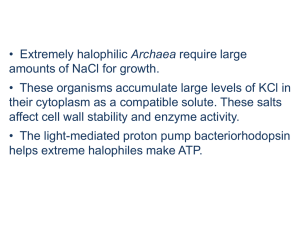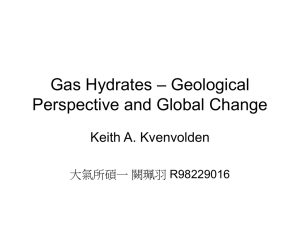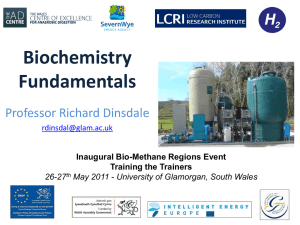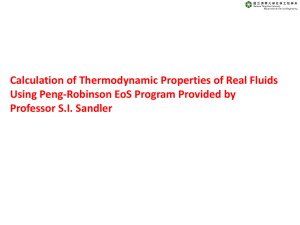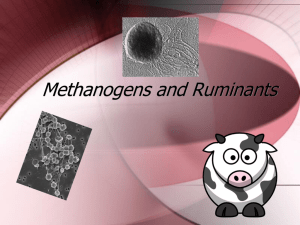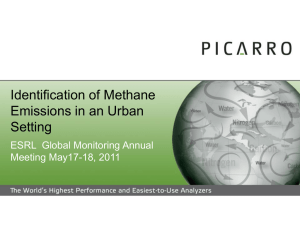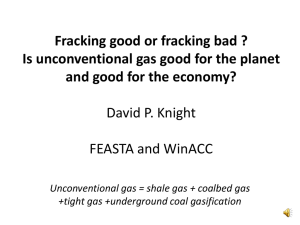methane
advertisement
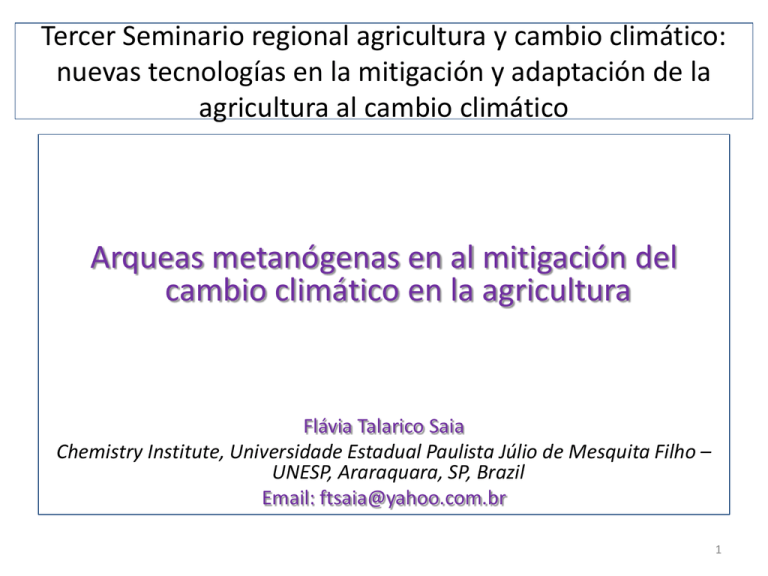
Tercer Seminario regional agricultura y cambio climático: nuevas tecnologías en la mitigación y adaptación de la agricultura al cambio climático Arqueas metanógenas en al mitigación del cambio climático en la agricultura Flávia Talarico Saia Chemistry Institute, Universidade Estadual Paulista Júlio de Mesquita Filho – UNESP, Araraquara, SP, Brazil Email: ftsaia@yahoo.com.br 1 CH4 as a source of energy Intergovernmental pane l on climate change (IPCC), 2007 METHANE 19th century anthropogenic Anaerobic treatment of waste Methane concentration in the atmosphere CH4 Recovered and used clean Fonte: NASA/Goddardas Space Flightenergy Center Methane to Market CH4 as a greenhouse gas Methane has global warming potential (GWP) 21-25 times more than CO2 Methane accounts for about 20% of global warming 2 • Mitigation strategies for methane emissions • Use of methane as a energy source • Sources of methane emission • Methanogenic microorganisms 3 THEY ARE THE ONLY MICROORGANISMS KNOWN THAT PRODUCE METHANE Methanogenesis: The Process Anaerobic condition 1 multi-step process carried out by different groups of microorganisms 1. Hydrolytic Bacteria 2. Fermentative Bacteria 3. Acetogenic Bacteria 4. Methanogenic Archaea 2 3 Hydrogenotrophic H2, formate Acetoclastic Acetate Methanobrevibacter Methanosaeta Methilotrophic Methanol Methanosarcina • It is important for carbon cycle since methanogenesis prevents a build-up of organic matter, allowing the other microorganisms to support the oxidation of substrates 5 Hydroeletric Rice fields wetlands Landfill WHERE ARE METHANOGENIC ARCHAEA ? Methanogens are ubiquitous in anoxic environments Anaerobic digesters Livestock - cattle Termites 6 Agriculture - source of methane Major sources of methane emissions: • Agriculture : In 2010 accounted for 53% of global methane emission • Energy: oil and natural gas systems • Waste: solid waste and wastewater treatment Yusulf et al. (2012) Renewable and Sustainable Energy Reviews 7 Agriculture sectors • Manure: stored or treated in liquid system - Top emmiting counties: U.S., Germany, India, China, France, Russia, Turkey and Brazil. Yusulf et al. (2012) Renewable and Sustenaible Energy Reviews 8 9 Agriculture - CH4 emissions in Brazil Agriculture sectors glogster.com Other sectors 4% Coal mining 8% Enteric Fementation 22% Manure Management 7% Biomass 11% Landfills 10% Wastewater Treatment 7% greencleanguide.com Agriculture accounting for 45% of CH4 emission Rice cultivation 16% novotempo.com Oil gas 15% Largest beef exporter in the world 10 10 Vinasse – liquid waste from ethanol Sugarcane Ethanol Vinasse Vinasse has been used as fertilizer to sugarcane fields •Emission of methane during storage of vinasse • Emission of N2O from soil Brazil is the largest producer of sugarcane ethanol in the world and immense volume of vinasse is generated – 10L vinasse/L ethanol In 2006/2007, 190 billions of liters of vinasse were produced Rego e Hernández (2006); Oliveira (2011); Carmo et al., 2012 11 Brazilian authorities announced that the country will target a reduction in its GHG between 36.1 and 38.9% from projected 2020 levels. The Intergovernmental Panel on Climate Change - IPCC (2007) 12 Mitigation Strategies: Enteric Fermentation • CH4 is not only GHG but it is also a waste of fed energy for the animal •Large number of MA are in the ruminal liquid: 107 to 109 cells/mL (Kamra, 2005). Hydrogenotrophic methanogens: Methanobacteriales, Methanomicrobiales, Methanosarcinales have been found Methanobrevibacter smithii Methanobacterium formicicum Methanosarcina barkeri 13 microbewiki Enteric Fermentation – mitigation strategies (MS) to methane emission MS target the methanogens of the rumen directly or indirectly • Diet Composition: use of easy degradable carbohydrate – reduce pH in the rumen – decreases MA. However, accumulation of organic acids can occur, leading to subacute ruminal acidosis (SARA) and disruption of the rumen microbiota (Plaizier et al., 2008). • Lipids: Fatty acids and oils (Johnson and Johnson, 1995; Hook et al., 2010). - inhibition of protozoa which supply methanogens with hydrogen - Increase the production of propionic acid - it is not used for methanogens - Binding to the cell membrane of methanogens and interrupting membrane transport • Defaunation: decrease the number of protozoa by the use of copper, sulphate, acids, (Hook et al., 2010) • Vaccines: target methanogens directly (Wedlock et al., 2010) Hook et al. (2010) 14 Enteric Fermentation – mitigation strategies (MS) to methane emission • Other strategies: selection of high quality grasses, increase grain level and increasing feed conversion efficiency to produce meat and milk Researches have shown: • MS are limited by the diet feed, the management conditions, physiological condition, use of the animal, and government laws. • Long-term experiments in vivo need to be done to implement MS • Economic viability of the producer needs to be addressed Brazil: diversty of methahogens related with diet – hay proportions (Neves et al., 2010) improvement of meat production related with sugarcane feeding in dry season (Primavesi et al., 2003) Hook et al. (2010); Yusuf et al., 2012 15 Rice fields CH4 is produced by anaerobic degradation of organic matter that occurs in soil and also in roots CH4 oxidation by methanotrophic bacteria Anaerobic CH4 oxidation www1.ethz.ch MS = net methane emission Phillipot et al. (2009), Dubey (2005) 16 • Acetoclastic but mainly hydrogenotrofic methanogens Methanolinea Methanobacterium kanagiense Sakai et al., 2012 Kitamura et al., 2011 Methanoculleus chikugoensis Dianou et al., 2011 • Methanotrophic bacteria Methylomonas koyamae sp Adachi et al 2001 Methylosinus Ogiso et al., 2011 17 Mitigation Strategies: Rice field • Mitigation strategies include: - reduction of methane production; increasing methane oxidation, lowering methane transport through the plant • Selection of cultivars with low exudation rates • To keep the soil as dry as possible in the off- rice season : adverse environmental condition for methanogenesis • Use of fertilizer: ammonium nitrate and sulphate instead of urea Current information is insufficient for the development of technology and strategy for reduction in methane emission To improve the knowldgement of methanogens and methanotrophic bacteria in soil and in roots Phillipot et al. (2009), Dubey (2005) 18 Mitigation Strategy: anaerobic treatment of manure and vinasse Aim: to apply anaerobic technology to PRODUCE METHANE for BIOENERGY PURPOSES Land applications (N, K, P) pathogenic microorganisms Methane has a high energy value (ΔHo= 816 kJ/mol or 102 kJ/e- eq) that can be captured through combustion and used for space heating or eletricity 19 • Studies have been carried out to better understand the anaerobic process in order to control the process and achieve optimum biogas yield Support medium Configuration of reactors UASB Polyhurethane foam HAIB • Effect of inhibitory substances: ammounium, salt content, sulphate, temperature Lettinga (1980) Foresti et al. (1995) 20 Microorganisms – biodigestors treating manure slurries • Methanosarcinaceae and Methanobacteriales are predominant in anaerobic reactors treating different kinds of manure • Due to high levels of ammonium, pointig out the importance of hydrogenotrophic methanogenesis (Netmman et al., 2010) Methanosarcina Methanomicrobium Methanobrevibacter 21 Microorganisms – biodigestors treating vinasse • Acetoclastic and hydrogenothrophic methanogens Methanosarcina microbewiki Methanomicrobium sp bacmap.wishartlab.com Methanosaeta Araújo et al. (2003) • Termophilic process – vinasse is produced at high temperatures (80-900C) Souza et al. (1992); Viana (2006); Ribas (2006) - sludge stable among harvests - It is necessary to decrease temperature - process is faster than mesophilic 22 Hydrogen and methane production Use of two -stage bioreactors to produce hydrogen and methane Vinasse Acidogenic reactor H2 and acids production Peixoto et al. (2012) Methanogenic reactor Consumption of acids and production of methane 23 Conclusions Emissions of methane from agriculture activities are a worlwide problem, mainly regarding enteric fermentation, rice field and manure managment In Brazil: contribution of vinasse used as fertilizer Studies have shown that there are mitigation strategies, however a better understanding of the microorganisms, the factors affecting symbiotic relation with other microbial population and their environment, also long term expriments are needed to implement MS 24 Brazil • Studies focused on microbial diversity: Amazon and Pantanal 25 Muchas gracias Flávia Talarico Saia ftsaia@yahoo.com.br 55 16 33019506 26


